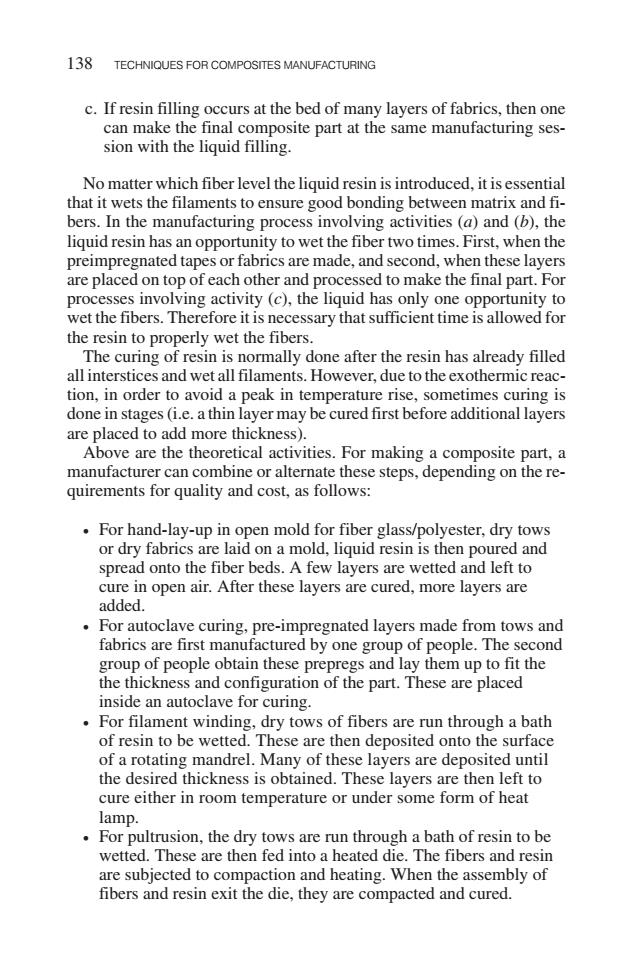正在加载图片...

138 TECHNIQUES FOR COMPOSITES MANUFACTURING c.If resin filling occurs at the bed of many layers of fabrics,then one can make the final composite part at the same manufacturing ses- sion with the liquid filling. No matter which fiber level the liquid resin is introduced,it is essential that it wets the filaments to ensure good bonding between matrix and fi- bers.In the manufacturing process involving activities(a)and(b),the liquid resin has an opportunity to wet the fiber two times.First,when the preimpregnated tapes or fabrics are made,and second,when these layers are placed on top of each other and processed to make the final part.For processes involving activity(c),the liquid has only one opportunity to wet the fibers.Therefore it is necessary that sufficient time is allowed for the resin to properly wet the fibers. The curing of resin is normally done after the resin has already filled all interstices and wet all filaments.However,due to the exothermic reac- tion,in order to avoid a peak in temperature rise,sometimes curing is done in stages(i.e.a thin layer may be cured first before additional layers are placed to add more thickness). Above are the theoretical activities.For making a composite part,a manufacturer can combine or alternate these steps,depending on the re- quirements for quality and cost,as follows: For hand-lay-up in open mold for fiber glass/polyester,dry tows or dry fabrics are laid on a mold,liquid resin is then poured and spread onto the fiber beds.A few layers are wetted and left to cure in open air.After these layers are cured,more layers are added. For autoclave curing,pre-impregnated layers made from tows and fabrics are first manufactured by one group of people.The second group of people obtain these prepregs and lay them up to fit the the thickness and configuration of the part.These are placed inside an autoclave for curing. For filament winding,dry tows of fibers are run through a bath of resin to be wetted.These are then deposited onto the surface of a rotating mandrel.Many of these layers are deposited until the desired thickness is obtained.These layers are then left to cure either in room temperature or under some form of heat lamp. For pultrusion,the dry tows are run through a bath of resin to be wetted.These are then fed into a heated die.The fibers and resin are subjected to compaction and heating.When the assembly of fibers and resin exit the die,they are compacted and cured.c. If resin filling occurs at the bed of many layers of fabrics, then one can make the final composite part at the same manufacturing session with the liquid filling. No matter which fiber level the liquid resin is introduced, it is essential that it wets the filaments to ensure good bonding between matrix and fibers. In the manufacturing process involving activities (a) and (b), the liquid resin has an opportunity to wet the fiber two times. First, when the preimpregnated tapes or fabrics are made, and second, when these layers are placed on top of each other and processed to make the final part. For processes involving activity (c), the liquid has only one opportunity to wet the fibers. Therefore it is necessary that sufficient time is allowed for the resin to properly wet the fibers. The curing of resin is normally done after the resin has already filled all interstices and wet all filaments. However, due to the exothermic reaction, in order to avoid a peak in temperature rise, sometimes curing is done in stages (i.e. a thin layer may be cured first before additional layers are placed to add more thickness). Above are the theoretical activities. For making a composite part, a manufacturer can combine or alternate these steps, depending on the requirements for quality and cost, as follows: • For hand-lay-up in open mold for fiber glass/polyester, dry tows or dry fabrics are laid on a mold, liquid resin is then poured and spread onto the fiber beds. A few layers are wetted and left to cure in open air. After these layers are cured, more layers are added. • For autoclave curing, pre-impregnated layers made from tows and fabrics are first manufactured by one group of people. The second group of people obtain these prepregs and lay them up to fit the the thickness and configuration of the part. These are placed inside an autoclave for curing. • For filament winding, dry tows of fibers are run through a bath of resin to be wetted. These are then deposited onto the surface of a rotating mandrel. Many of these layers are deposited until the desired thickness is obtained. These layers are then left to cure either in room temperature or under some form of heat lamp. • For pultrusion, the dry tows are run through a bath of resin to be wetted. These are then fed into a heated die. The fibers and resin are subjected to compaction and heating. When the assembly of fibers and resin exit the die, they are compacted and cured. 138 TECHNIQUES FOR COMPOSITES MANUFACTURING